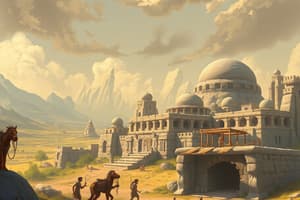Podcast
Questions and Answers
What marks the end of the prehistoric period?
What marks the end of the prehistoric period?
- The creation of rock art
- The discovery of agriculture
- The establishment of permanent settlements
- The discovery of writing (correct)
Which of the following is NOT a basic type of Paleolithic art?
Which of the following is NOT a basic type of Paleolithic art?
- Mobiliary Art
- Petroglyphs
- Cubism (correct)
- Pictographs
During which stage of the Paleolithic Period did cave paintings primarily develop?
During which stage of the Paleolithic Period did cave paintings primarily develop?
- Middle Paleolithic
- Lower Paleolithic
- Upper Paleolithic (correct)
- Mesolithic
What is a characteristic of Mobiliary Art?
What is a characteristic of Mobiliary Art?
What type of art primarily consisted of images painted on cave walls by prehistoric people?
What type of art primarily consisted of images painted on cave walls by prehistoric people?
Which petroglyphs are considered the oldest known artworks in the Rizal region of the Philippines?
Which petroglyphs are considered the oldest known artworks in the Rizal region of the Philippines?
What significant transition marks the end of the Mesolithic Period?
What significant transition marks the end of the Mesolithic Period?
Which of the following caves is known for paintings that date back to around 39,000 BCE?
Which of the following caves is known for paintings that date back to around 39,000 BCE?
What is one reason sculptures were less common in prehistoric society?
What is one reason sculptures were less common in prehistoric society?
Which of the following best describes petroglyphs?
Which of the following best describes petroglyphs?
What is the function of Ancient Egyptian art in relation to the afterlife?
What is the function of Ancient Egyptian art in relation to the afterlife?
What type of art is referred to as Parietal Art?
What type of art is referred to as Parietal Art?
The Venus of Willendorf is known for being:
The Venus of Willendorf is known for being:
Which cave art technique involves using large stones as a medium?
Which cave art technique involves using large stones as a medium?
Which of the following best describes the representation in Ancient Egyptian art?
Which of the following best describes the representation in Ancient Egyptian art?
What characterizes the hierarchy of scale in Ancient Egyptian art?
What characterizes the hierarchy of scale in Ancient Egyptian art?
Flashcards are hidden until you start studying
Study Notes
Prehistoric Period Overview
- Began with the appearance of humans and ended with the discovery of writing.
- Divided into distinct cultural phases: Paleolithic, Mesolithic, and Neolithic.
Paleolithic Period (Stone Age)
- Characterized by a hunter-gatherer culture.
- Three stages:
- Lower Paleolithic (2,500,000 to 2,000,000 BCE)
- Middle Paleolithic (200,000 to 40,000 BCE)
- Upper Paleolithic (40,000 to 10,000 BCE)
Mesolithic Period
- Transitional phase following the Upper Paleolithic.
- Ended with the advent of agriculture.
Neolithic Period
- Emergence of permanent settlements.
- Development of farming techniques and domestication of animals.
Types of Paleolithic Art
- Petroglyphs: Rock surface carvings; found globally in regions such as South Africa, Australia, and Europe.
- Prehistoric sculpture: Less common due to nomadic lifestyles.
- Pictographs: Visual symbols that convey ideas; includes cave paintings.
- Megalithic art: Involves large stones for artistic expression.
Art Subcategories
- Parietal Art: Art on immovable rock surfaces.
- Mobiliary Art: Portable artworks.
Notable Petroglyphs
- Angono Petroglyphs: Oldest known artworks in the Philippines (5,000 years old); over 120 figures; classified as a National Treasure.
- Bhimbetka Petroglyphs: Estimated at 290,000-700,000 BCE; oldest cave art in India.
- Daraki-Chattan Petroglyphs: Similar timeframe to Bhimbetka.
Cave Paintings
- Predominantly depict animals, including predators like bears and reindeer.
- Famous sites:
- Cave of El Castillo, Spain (39,000 BCE)
- Altamira Cave, Spain (34,000-15,000 BCE)
- Chauvet Cave, France (30,000 BCE)
- Lascaux Cave, France (17,000-13,000 BCE)
- Cosquer Cave, France (25,000 BCE)
Sculptures
- Notably scarce due to mobility of prehistoric communities.
- Significant examples include:
- Venus of Berekhat Ram: Earliest known sculpture (700,000-230,000 BCE).
- Venus of Willendorf: Popular female statuette (28,000-25,000 BCE).
- Venus of Brassempoy: Early lifelike representation (25,000 BCE).
Megalithic Art
- Involves large stones used in construction, such as burial chambers and tombs.
Ancient Egyptian Art
- Flourished from 3,000 BC to 30 AD; pyramids as architectural highlights.
- Functions:
- Glorify gods and Pharaohs.
- Facilitate afterlife transitions.
- Preserve cultural values.
- Characteristics:
- Statues depict idealized figures.
- Hierarchy of Scale: size reflects importance; larger figures indicate higher status.
Studying That Suits You
Use AI to generate personalized quizzes and flashcards to suit your learning preferences.



